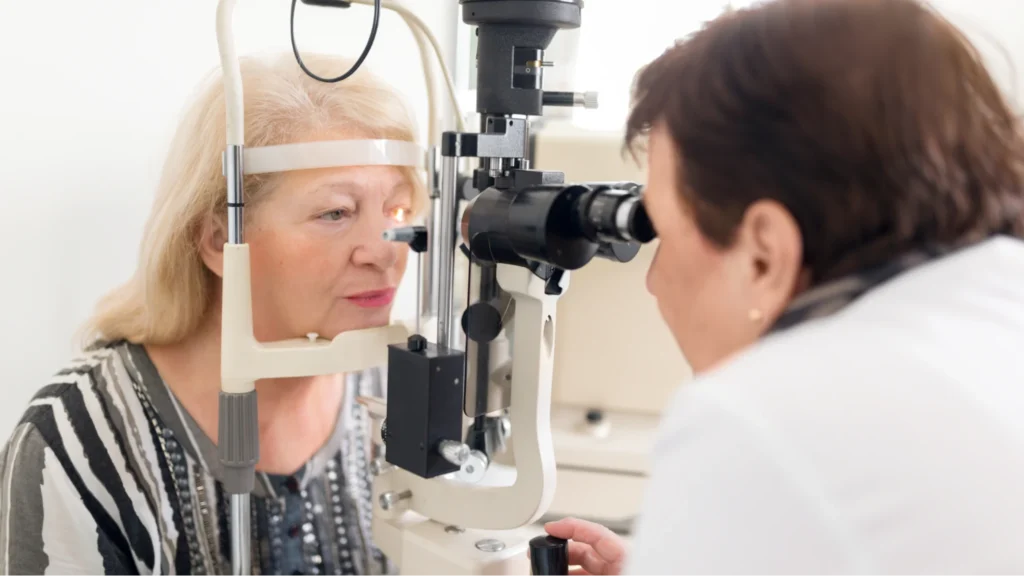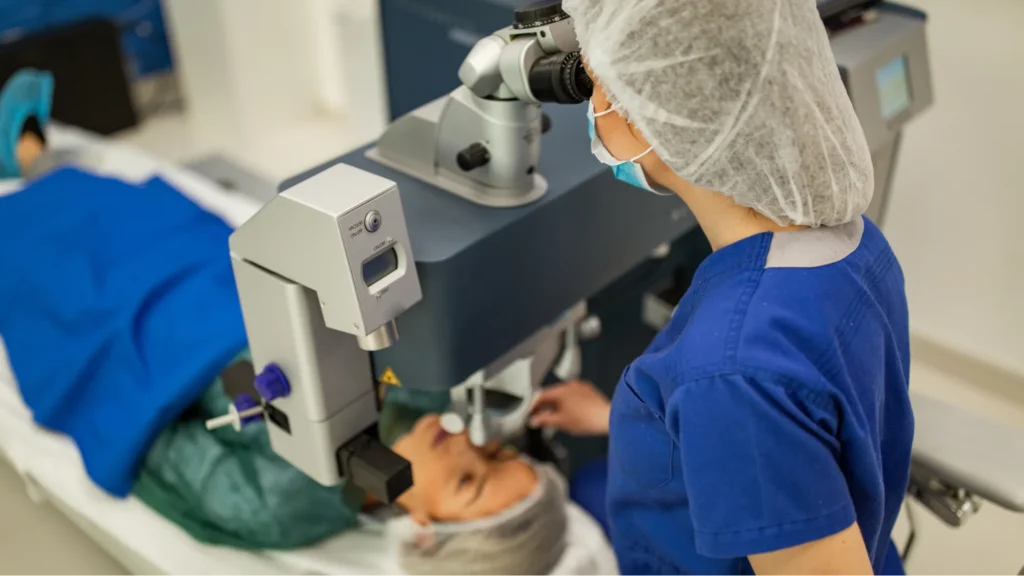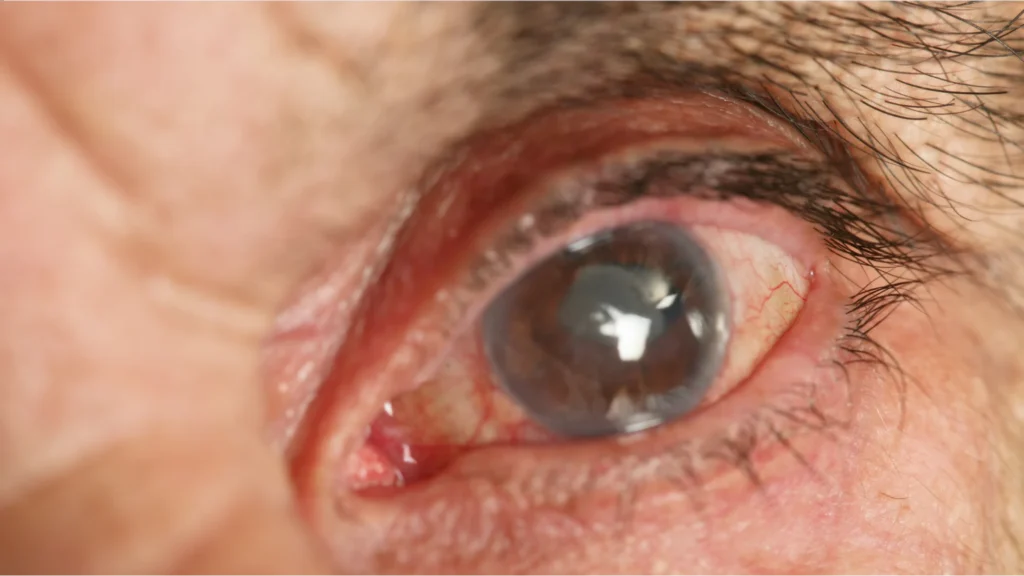Glaucoma is called the “silent thief of sight” for good reason—most folks don’t notice a thing until vision loss shows up. If you’re over 40, have a family history, or live with diabetes or high blood pressure, this blog is for you. Here, you’ll learn the early warning signs of glaucoma symptoms, find out which glaucoma screening tests matter, and see how modern glaucoma treatment options—from eye drops to minimally invasive glaucoma surgery (MIGS)—can slow or stop progression. Stick around, and you’ll walk away with clear next steps to protect your sight before it’s too late.
What Is Glaucoma
Glaucoma is a sneak attack on your vision. It covers a group of eye diseases that damage the optic nerve, the bundle of fibers that carries images from your eyes to your brain. Most often, problems start when pressure inside the eye creeps up. That extra pressure squeezes the optic nerve fibers, causing slow, painless vision loss, usually starting at your side vision, so you hardly notice it.
Why Glaucoma Early Detection Matters
Early detection is a game-changer. If caught in the first stages, treatment can slow or stop damage before you lose more sight. Picture a tiny leak in a dam: fix it early, and you avoid a flood. Regular eye pressure checks, optic nerve scans, and visual field tests act like early warning alarms. They catch rising pressure or nerve changes that you wouldn’t spot just by looking at the world.
Without screening, glaucoma can steal vision bit by bit until central vision is at risk. But with a simple tonometry test or an OCT scan at LMC Optometry & Eye Care, we can spot red flags long before you bump into door frames or struggle to read the dashboard. Starting eye drops, laser therapy, or surgery early keeps your vision strong, so you keep enjoying daily life, whether it’s reading bedtime stories or cruising around the GTA without worry.
Recognizing Silent Warning Signs
Your eyes rarely send an SOS when something’s off. Glaucoma creeps in quietly, so knowing what to look for is key. In this section, we’ll break down subtle signs—like tiny blind spots or missing edges in your vision—and show you why spotting them early can save your sight.
- Gradual Peripheral Vision Loss
You might bump into doorframes or miss items at the edge of your vision. - Patchy Blind Spots
Tiny areas of lost vision in one or both eyes. - Tunnel Vision (Advanced Stages)
A “tunnel” effect where you seem to lose side vision.
Who’s at Risk? Key Glaucoma Risk Factors
Everyone’s eyes are unique, but some people face higher odds of developing glaucoma. Knowing these factors helps you and your family plan timely check-ups and dodge surprises down the road.
- Age 40 and Over (especially over 60)
- Family History of Glaucoma
- Ethnicity: Higher rates in Black, Hispanic, and Asian communities
- Chronic Conditions: Diabetes, high blood pressure, long-term steroid use
- Eye Anatomy: Thin corneas, high myopia
- Trauma or Surgery: Past eye injury or operations

Essential Glaucoma Screening Tests
Even though glaucoma is sneaky, the tests to catch it are quick and painless. These basic checks give your eye doctor the clues they need to spot trouble early. Here’s what happens during a screening, so you know exactly what to expect.
- Intraocular Pressure (IOP) Test: A quick puff of air or gentle applanation measures your eye pressure.
- Optic Nerve Imaging: OCT scans map nerve-fiber layers in detail.
- Visual Field Test: You press a button when you see tiny lights, charting blind spots.
- Gonioscopy: Examines the drainage angle, critical to distinguish open-angle vs. angle-closure glaucoma.
Types of Glaucoma You Should Know
Every case of glaucoma isn’t the same. Some sneak in slowly, while others can strike fast and furious. Knowing which form you might face helps you spot symptoms sooner and pick the right treatment path.
- Open-Angle Glaucoma
The most common form—often painless, slow progression. - Angle-Closure Glaucoma
Sudden eye-pain attack, halos around lights, nausea—an emergency. - Normal-Tension Glaucoma
Optic-nerve damage despite normal IOP requires careful monitoring.
First-Line Treatments: Eye Drops & Medications
Eye drops lower eye pressure by either decreasing fluid production or improving drainage. Common classes include:
- Prostaglandin Analogues
- Beta Blockers
- Alpha Agonists
- Carbonic Anhydrase Inhibitors
Stick to your dosing schedule. Missed doses can let pressure spike.
Laser Surgery for Glaucoma
Laser treatments for glaucoma can save precious vision by opening clogged drainage pathways in just a few minutes. You’ll stay awake, feel minimal discomfort, and head home the same day. Whether it’s a quick laser trabeculoplasty to ease pressure in open-angle glaucoma or an iridotomy to prevent angle-closure attacks, these in-office procedures work by boosting fluid outflow from the eye. Below, we’ll break down the main laser options so you know what to expect.
- Trabeculoplasty for open-angle glaucoma uses a laser to improve drainage.
- Iridotomy for angle-closure creates a tiny hole in the iris to open fluid flow.
These in-office procedures take minutes, often with minimal downtime.
Cutting-Edge: Minimally Invasive Glaucoma Surgery (MIGS)
Minimally invasive glaucoma surgery (MIGS) brings advanced technology to treat glaucoma with tiny implants or micro-stents—no large incisions or long hospital stays. These small devices sit quietly inside your eye, creating new drainage pathways so fluid can flow out smoothly and pressure stays in check. It offers the following benefits:
- Shorter recovery
- Fewer complications than traditional surgery
- Can be combined with cataract removal
Popular options: the iStent, Hydrus Microstent, and XEN Gel Stent.

Traditional Glaucoma Surgery: Trabeculectomy & Shunts
When drops and laser treatments don’t do the trick, your surgeon may turn to traditional surgery to get eye pressure under control. In a trabeculectomy, the surgeon creates a tiny flap in the white part of your eye (the sclera) and makes a new drainage channel under a thin layer of tissue. Fluid seeps out into a small bleb (a blister‑like pocket) under your eyelid, where it’s absorbed.
If that option isn’t right—due to scarring or other factors—a tube‑shunt implant (often called a glaucoma drainage device) might be used instead. A slender tube is placed in the eye’s front chamber, and the other end sits under the sclera, letting fluid drain into a reservoir plate.
Pros:
- Can slash eye pressure dramatically, often by 30–50%
- Effective for advanced or resistant glaucoma
Cons:
- Longer healing (4–6 weeks) with close monitoring
- Risks of bleb‑related infections, leaks, or scarring
- Possible low pressure (hypotony) if too much fluid drains
While traditional surgery carries more downtime, it remains a powerful option when earlier treatments aren’t enough. By creating a reliable exit route for fluid, trabeculectomy and shunts can protect your optic nerve and preserve vision for years to come.
What to Expect After Glaucoma Surgery
- Mild discomfort and redness
- Frequent antibiotic/steroid drops for several weeks
- Follow-up visits to check pressure and healing
- Avoid heavy lifting or bending for a few weeks
Patience and post-op care are key to success.
Monitoring & Follow-Up: Staying on Top of Your Eye Health
Glaucoma care is lifelong. You’ll need regular check-ups (every 3–12 months, depending on severity) that include:
- IOP measurement
- Visual field tests
- OCT imaging
Keep a log of your pressures and symptoms.
Lifestyle Tips to Prevent Glaucoma Vision Loss
Making small daily changes can help keep eye pressure low and protect your optic nerve. These easy habits fit into any routine, whether you’re at home, work, or out enjoying Toronto’s parks. Give them a try and see the difference they can make.
- Exercise Moderately: Brisk walking can lower eye pressure.
- Healthy Diet: Leafy greens, omega-3 fatty acids, and antioxidants support overall eye health.
- Protect from UV Damage: Wear sunglasses with 100% UV protection outdoors.
- Mind Your Meds: Steroids can raise eye pressure—discuss risks with your doctor.
- Screen Time Breaks: Every 20 minutes, look 20 feet away for 20 seconds to reduce eye strain.
Living with Glaucoma: Coping & Support
Living with glaucoma means joining a team effort—yours and ours—to keep your vision steady. You might face new daily guesses about light levels or readjusting how you move around your home. With the right tools, habits, and support network, you’ll find ways to stay independent and confident. Here’s how to get started:
- Adjust Your Home: Brighter lighting, high-contrast labels, large-print clocks.
- Join a Support Group: Sharing tips can ease stress and improve adherence.
- Consider Low-Vision Aids: Magnifiers, text-to-speech devices, apps.
- Talk to Family: Let loved ones know your needs and warning signs of attacks.
FAQs About Early Glaucoma Detection
How often should I get screened?
Every 2–4 years if you’re over 40 with no risks. Annually, if you have risk factors.
Can glaucoma be cured?
Not cured, but managed. Early action can keep your vision stable for life.
Are eye drops safe long-term?
Yes—most people tolerate them well. Let your doctor know if you have side effects.
Will I go blind?
With modern treatments and regular follow-up, most people never lose functional vision.
Should I opt in for OCT imaging? YES, this provides critical details regarding the optic nerve, allowing for early detection and monitoring of disease progression.
Taking Action: Your Glaucoma Management Plan
Glaucoma doesn’t wait. If you’re 40 or older—or have risk factors—schedule a glaucoma screening at LMC Optometry & Eye Care today. Early detection and consistent care protect your vision over time. We’ll guide you through each test and treatment step so you can enjoy clear sight for years ahead.
Next Step: Schedule your glaucoma screening now to start safeguarding your eyes.



